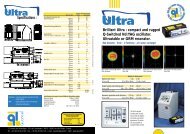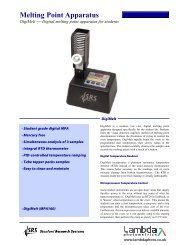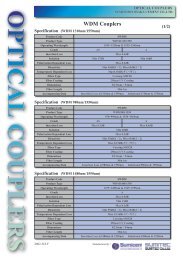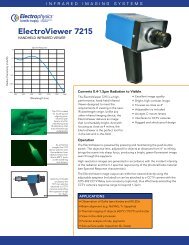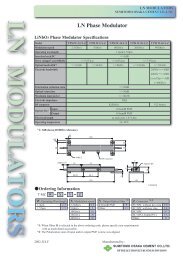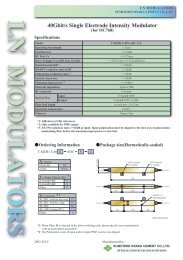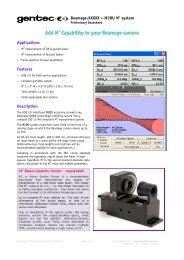BeamScope™-P8 - Lambda Photometrics
BeamScope™-P8 - Lambda Photometrics
BeamScope™-P8 - Lambda Photometrics
You also want an ePaper? Increase the reach of your titles
YUMPU automatically turns print PDFs into web optimized ePapers that Google loves.
BeamScope<br />
Measurable Sources<br />
Measured Beam Powers<br />
Optical Dynamic Range<br />
Shape of Maximum Scanned<br />
Area<br />
Pinholes (PA series)<br />
Single Slits (SS series)<br />
X-Y Slits (XY series)<br />
2-D Stage (M2B)<br />
Measured Beam<br />
Diameters/Widths<br />
Measurement Resolution<br />
Measurement Accuracy<br />
Measured Beam Profiles<br />
Measured Profile Parameters<br />
Displayed Profiles (Note 1)<br />
Update Rate<br />
Data Analysis<br />
Pass/Fail<br />
Averaging<br />
Standard Deviation<br />
Power Measurement<br />
Source to Slit Distance<br />
Aperture sizes (Note 2 )<br />
Slits<br />
Pinholes<br />
Wavelength Range<br />
Silicon Detector<br />
Germanium Detector<br />
InAs<br />
Mounting<br />
Temp. Range (inc. Accessories)<br />
Operating<br />
Storage<br />
Minimum PC Requirements<br />
(Mac version is not available)<br />
<strong>P8</strong> Product Specifications [Subject to change without notice.]<br />
CW or<br />
Pulsed sources: >5kHz Pulse Repetition Rate @ 5% duty factor. Higher PRR is better<br />
See the graph in the Notes, below.<br />
E.g. 6 μW to 3 W, for a 1 mm diameter (1/e 2 ) Gaussian beam @ 633 nm, 5 μm slit.<br />
55 dB (= 300,000:1) [75 dB with Neutral Density 2.0 film<br />
Important: For accurate measurements, beamwidth should be < 0.5 x Scan Dimens<br />
With /EPH extended probe head, dimension 23 mm below, becomes 35 mm.<br />
Shape Cross Scan x Scanned Length<br />
Line Scan Pinhole diameter x 23 mm<br />
Rectangle 7* x 23 mm, (* 5 for Ge, 3 for InAs<br />
Trapezoid 5* x 15/5 mm, (* 3 for Ge, 2 for InAs, 3.5 x 13.5/6.5 for XYPl5)<br />
Rectangle 45 x 23 mm scanned area image. Scans a pinhole over this area.<br />
0.5 μm to ~25 mm (Defined as the 1/e 2 diameter, = 13.5% of peak for Gaussian bea<br />
0.5 μm, or 0.5% of the measured beam diameter, whichever is greater<br />
±1μm ±2% of measured beam diameter<br />
X & Y<br />
Linear & logarithmic profile display modes<br />
Gaussian beam diameter<br />
Gaussian fit<br />
Second Moment beam diameter<br />
Knife-Edge beam diameter<br />
Centroid position, relative and absolute<br />
Ellipticity + Orientation of Major Axis<br />
Beam Wander display<br />
X only, Y only, X & Y<br />
2-D plot (10,16 or 256 colors)<br />
3-D plot (10,16 or 256 colors)<br />
1 to 2 Hz. Depends upon the PC Processor Speed, Scanned Profile & Selected<br />
Options<br />
On all measured parameters, on-screen, in selectable Pass/Fail colors<br />
Beam Diameter Running Average and Accumulating Average options<br />
On Accumulation Averaging Screen<br />
Units of mW, dBm, dB, % or user entered (relative to a reference measurement<br />
provided by the user.)<br />
1.0 mm minimum<br />
Important: See Scanned Area (above ) for measurable beam dimensions<br />
2.5, 5, 10, 25 and 100 μm wide 7 mm long<br />
(Planar version of 5 μm slits are 5 mm long)<br />
5, 10, 25 and 50 μm diameter (Larger or smaller pinholes to special order)<br />
190 to 1150 nm<br />
800 to 1800 nm<br />
1500 to 4 µm<br />
¼-20 & M6 threaded mounting holes<br />
10 o to 35 o C<br />
5 o to 45 o C<br />
USB2.0 port, Windows XP or Vista; 512 MB RAM; 10 MB Hard Drive space;<br />
1024x768 monitor.



